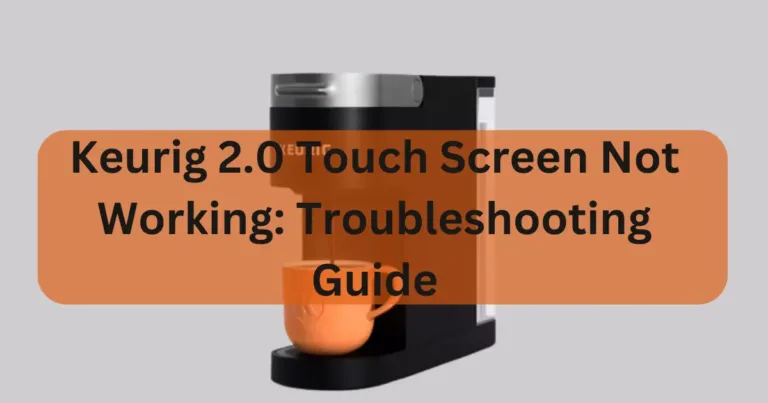Why Is My Nespresso Machine Leaking and How to Fix It?
Are you waking up in the morning, eagerly anticipating your daily cup of coffee, only to find that your beloved Nespresso machine is leaking? Don’t worry, you’re not alone. Leaking Nespresso machines can be a frustrating problem, but it’s important to remember that they are not indestructible. Wear and tear, as well as neglecting regular maintenance can lead to leaks. In this article, we will delve into the possible causes of your Nespresso machine leaking and offer some practical solutions to help you fix it.
Contents
- 1 Possible Causes of Nespresso Machine Leaks
- 2 How to Fix a Leaking Nespresso Machine
- 2.1 descaling issues
- 2.2 Blockages in the Coffee Outlet or Capsule Holder
- 2.3 Damaged Water Tank Valve Seal
- 2.4 Internal Component Issues
- 2.5 Checking and Adjusting the Water Reservoir
- 2.6 Inspecting and Replacing Seals
- 2.7 Cleaning and Clearing the Brew Unit
- 2.8 Repairing or Replacing the Pressure System
- 3 Preventing Leaks and Extending the Lifespan of Your Nespresso Machine
- 4 Conclusion
- 5 FAQs
Possible Causes of Nespresso Machine Leaks
Several common culprits may cause your Nespresso machine to leak. Let’s take a closer look at each of these issues and explore potential solutions.
Descaling Issues
One of the most common reasons for a leaking Nespresso machine is the buildup of limescale. The water used to brew your coffee leaves behind minerals that accumulate over time, causing blockages and affecting the water flow. Nespresso recommends descaling your machine every three months or after 300 coffee capsules, whichever comes first. If you have hard water, you may need to descale more frequently.
To descale your Nespresso machine, it is best to use a descaling solution specifically designed for coffee machines. Homemade remedies using vinegar may not be as effective. Nespresso offers an official descaling solution kit that is compatible with all Original models. Alternatively, you can consider popular descaling products like Impresa Coffee Machine Cleaner or De’Longhi EcoDecalk Cleaner.
Blockages in the Coffee Outlet or Capsule Holder
Neglecting to clean your Nespresso machine regularly can lead to blockages in the coffee outlet or capsule holder. Coffee grinds and residue can accumulate, impeding the water flow and causing leaks. It is essential to empty used capsules promptly and wipes them under the coffee outlet to remove any buildup.
To clean the pod holder and coffee outlet, you can use a toothbrush and warm, soapy water. Gently scrub the affected areas and run a hot water cycle to flush out any loosened debris. For stubborn buildup, a wire brush may be necessary. However, exercise caution and refer to your machine’s user manual or contact customer service to avoid damaging the machine.
Damaged Water Tank Valve Seal
If you notice water pooling around the bottom of your Nespresso machine, there may be an issue with the water tank valve seal. The rubber seal at the base of the water reservoir is designed to prevent water from leaking when the brewer is not in use. Over time, this seal can become worn down or loose, leading to leaks.
To test for a faulty water tank valve seal, remove and empty the water tank, then fill it with fresh water and place it upright on paper towels. If the paper towel becomes damp after a couple of hours, it indicates a loose seal. You can contact Nespresso support to inquire about purchasing a new tank or search for a compatible water tank on platforms like Amazon.
Internal Component Issues
If you have ruled out descaling, blockages, and water tank issues, the cause of your Nespresso machine leaking may be related to broken internal components. The thermoblock, pump, or internal pipework could be damaged, particularly if you have used vinegar for descaling. These issues are more prevalent in certain models, such as Vertuo Next.
Diagnosing and replacing these internal components can be complicated and may void your machine’s warranty. It is advisable to contact Nespresso support if your machine is still under warranty. They can guide you through the repair process or provide a replacement machine if necessary.
Water Reservoir Issues
One of the primary reasons your Nespresso machine may be leaking is due to problems with the water reservoir. Check if the reservoir is properly inserted and secured. If it’s not positioned correctly or if there are any cracks or damages, it can lead to leaks. Ensure that the water reservoir is firmly in place and free from any defects.
Damaged or Misaligned Seals
Seals play a vital role in preventing leaks in your Nespresso machine. Over time, these seals can become worn out or misaligned, resulting in water leakage. Inspect the seals carefully, looking for any signs of damage or displacement. If you notice any issues, it’s recommended to replace the seals to ensure a proper fit and prevent leaks.
Clogged Brew Unit
A clogged brew unit can also be a culprit behind the leaking Nespresso machine. If the brew unit is obstructed or dirty, it can interfere with the proper flow of water, leading to leaks. Regularly clean the brew unit and ensure that it’s free from any debris or coffee residue to avoid clogs and potential leaks.
Malfunctioning Pressure System
The pressure system in a Nespresso machine is responsible for delivering optimal brewing conditions. If there’s a malfunction in this system, it can cause leaks. In such cases, it’s advisable to contact the manufacturer or a professional technician to assess and repair the pressure system.
How to Fix a Leaking Nespresso Machine
descaling issues
To address descaling issues that may cause leaks in your Nespresso machine, follow these steps:
Descaling is essential to remove limescale buildup. Use a descaling solution specifically designed for coffee machines, as homemade remedies using vinegar may not be as effective.
Nespresso offers an official descaling solution kit compatible with all Original models. Alternatively, you can consider popular descaling products like Impresa Coffee Machine Cleaner or De’Longhi EcoDecalk Cleaner.
Follow the descaling instructions provided by the manufacturer for your specific Nespresso model. Typically, it involves mixing the descaling solution with water and running a descaling cycle.
Repeat the descaling process every three months or after 300 coffee capsules, or more frequently if you have hard water.
Blockages in the Coffee Outlet or Capsule Holder
To address blockages in the coffee outlet or capsule holder that may cause leaks in your Nespresso machine, follow these steps:
Regularly clean your Nespresso machine by emptying used capsules promptly and wiping under the coffee outlet to remove any buildup.
Use a toothbrush and warm, soapy water to clean the pod holder and coffee outlet. Gently scrub the affected areas and run a hot water cycle to flush out any loosened debris.
For stubborn buildup, consult your machine’s user manual or contact customer service for guidance. Avoid using abrasive tools that may damage the machine.
Damaged Water Tank Valve Seal
To address a faulty water tank valve seal that may cause leaks in your Nespresso machine, consider the following steps:
If you notice water pooling around the bottom of the machine, there may be an issue with the water tank valve seal.
Test the seal by removing and emptying the water tank, filling it with fresh water, and placing it upright on paper towels. If the paper towel becomes damp after a couple of hours, it indicates a loose seal.
Contact Nespresso support to inquire about purchasing a new water tank or search for a compatible replacement tank on platforms like Amazon.
Internal Component Issues
If descaling, blockage cleaning, and water tank inspection do not resolve the leaking issue, it may be related to broken internal components. Follow these steps:
If your Nespresso machine is still under warranty, contact Nespresso support. They can guide you through the repair process or provide a replacement machine if necessary.
Avoid attempting to diagnose or replace internal components yourself, as it may void the warranty and cause further damage.
Provide Nespresso support with detailed information about the issue, such as the model of your machine and any relevant symptoms, to help them assist you effectively.
Checking and Adjusting the Water Reservoir
To address leaks related to the water reservoir, start by removing it from the machine and inspecting it for any damages. If you find any cracks or defects, replace the reservoir with a new one. Ensure that the reservoir is correctly positioned and securely attached to the machine to prevent leaks.
Inspecting and Replacing Seals
Carefully examine the seals in your Nespresso machine for signs of wear and tear. If the seals are damaged or misaligned, replace them with new ones. Refer to the manufacturer’s instructions or contact customer support for guidance on the specific seal replacement process for your model. Properly fitted seals will help eliminate leaks.
Cleaning and Clearing the Brew Unit
Regular cleaning of the brew unit is crucial to avoid clogs and leaks. Follow the manufacturer’s instructions to disassemble the brew unit and clean it thoroughly. Remove any coffee grounds or debris that might be causing blockages. Once cleaned, reassemble the brew unit securely, ensuring it’s positioned correctly.
Repairing or Replacing the Pressure System
If you suspect that a malfunctioning pressure system is causing the leaks, it’s best to seek professional help. Contact Nespresso customer support or an authorized service center to diagnose and repair the pressure system. Attempting to fix it yourself might lead to further complications or void the warranty.
Preventing Leaks and Extending the Lifespan of Your Nespresso Machine
Now that you have addressed the leaking issue with your Nespresso machine, it’s crucial to take steps to prevent future leaks and extend its lifespan. Here are some tips to help you maintain your machine:
Regular Descaling
To prevent limescale buildup and maintain optimal performance, make descaling a regular part of your maintenance routine. Follow Nespresso’s recommended descaling schedule, and use a high-quality descaling solution for best results.
Proper Cleaning
Clean your Nespresso machine regularly to prevent coffee grinds and residue from causing blockages. Empty used capsules promptly, wipe under the coffee outlet and clean the pod holder with warm, soapy water. Running a hot water cycle periodically can help clear any remaining debris.
Use Filtered Water
Consider using filtered water in your Nespresso machine to minimize mineral deposits and limescale buildup. This can help prolong the lifespan of your machine and improve the taste of your coffee.
Follow Manufacturer Instructions
Always refer to the manufacturer’s instructions and guidelines for your specific Nespresso model. This will ensure that you are using and maintaining your machine correctly, reducing the risk of leaks and other issues.
Regular Maintenance
In addition to descaling and cleaning, perform regular maintenance tasks like checking seals, inspecting internal components, and replacing any worn or damaged parts. This proactive approach can help identify potential issues before they lead to leaks or other malfunctions.
Handling the Machine with Care
Handle your Nespresso machine with caution to prevent accidental damages that may lead to leaks. Avoid placing heavy objects on top of the machine, as it can cause stress on the internal components. Gently insert and remove the capsules, ensuring they fit correctly to avoid any spillage or leaks.
Conclusion
A leaking Nespresso machine can be a frustrating experience, but with the right knowledge and maintenance routine, you can resolve the issue and prevent future leaks. Remember to descale regularly, clean the coffee outlet and pod holder, check the water tank valve seal, and perform regular maintenance tasks. By taking these steps, you can enjoy your favorite Nespresso coffee without any unwanted surprises.
So, the next time you encounter a leaking Nespresso machine, don’t panic. Take a deep breath, follow our troubleshooting guide, and you’ll be back to brewing flawless coffee in no time.
FAQs
Why is my Nespresso machine leaking underneath?
Leaking underneath a Nespresso machine can be caused by factors such as a misaligned water tank, damaged seal, clogged brew unit, internal hose or pipe leak, or scale buildup. Ensure the water tank is securely placed, inspect the seal for damage, clean the brew unit, and descale regularly. Contact Nespresso support for further assistance if needed.
Why is my Nespresso machine leaking only when brewing?
If your Nespresso machine only leaks during the brewing process, it could indicate a clog in the brew unit or a malfunctioning pressure system. Cleaning the brew unit and contacting customer support for assistance with the pressure system can help resolve the issue.
Can I use any sealant to fix the leaks in my Nespresso machine?
It’s not recommended to use sealants or adhesives to fix leaks in your Nespresso machine. Opt for replacing the damaged or misaligned seals with new ones to ensure proper functioning.
How often should I clean my Nespresso machine to prevent leaks?
It’s advisable to clean your Nespresso machine regularly, following the manufacturer’s instructions. Depending on your usage, a thorough cleaning every 1-2 months is typically recommended.
Can using low-quality coffee capsules cause leaks?
While low-quality coffee capsules might not directly cause leaks, they can contribute to clogs and blockages in the brew unit, leading to leaks. It’s best to use high-quality, compatible capsules recommended by Nespresso.









One Comment